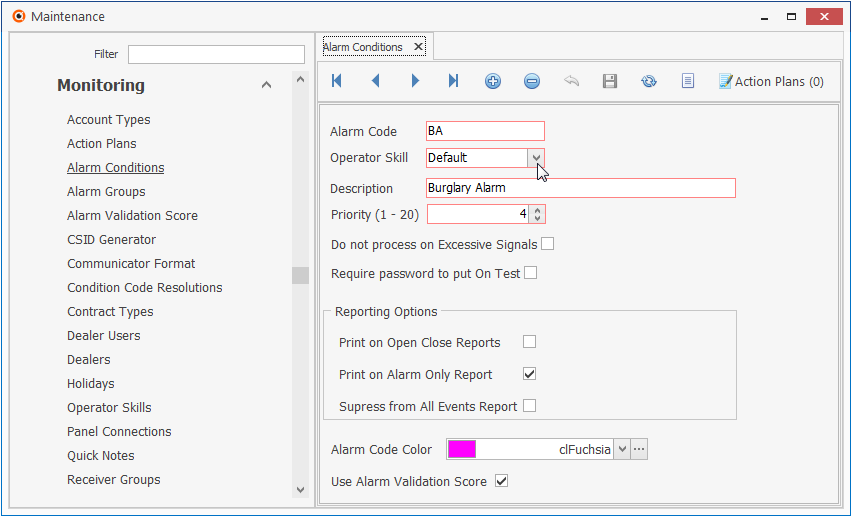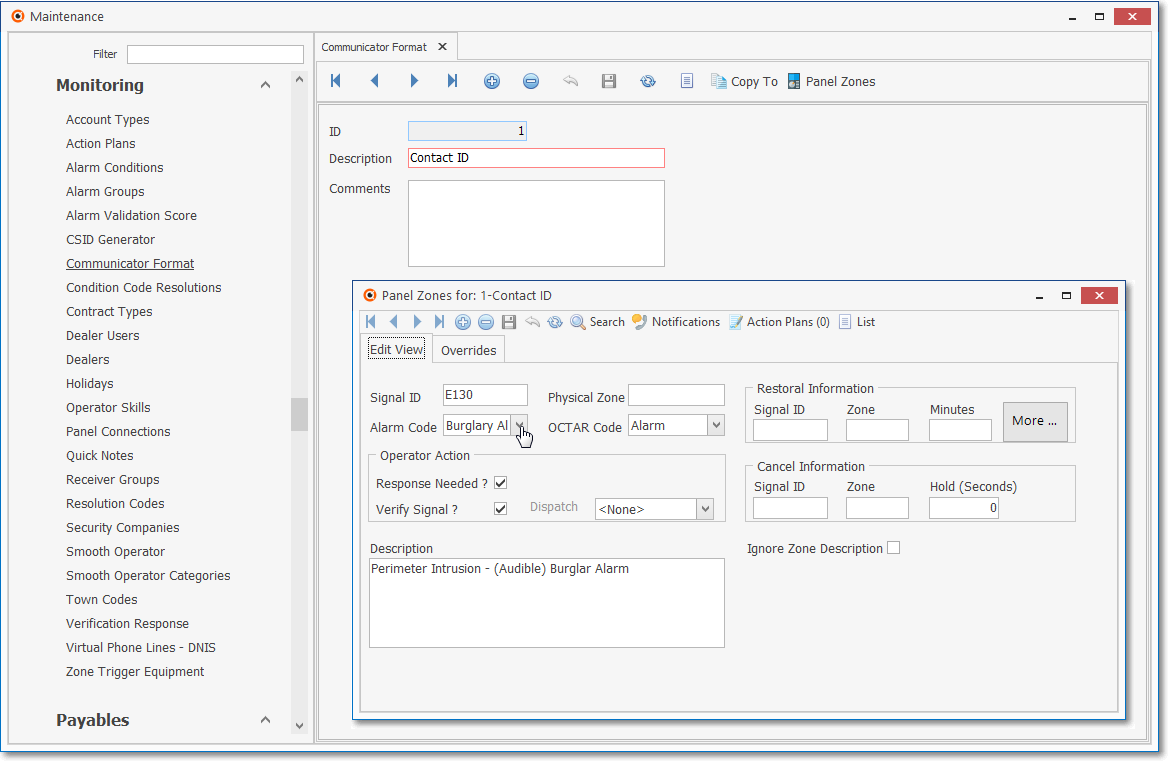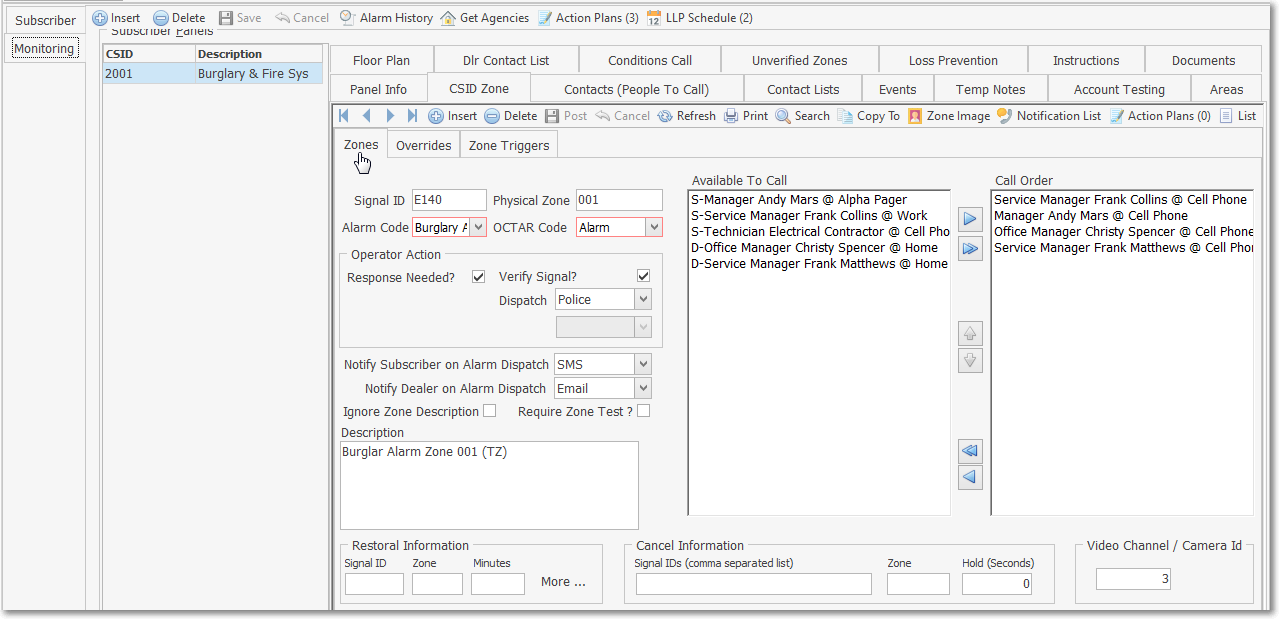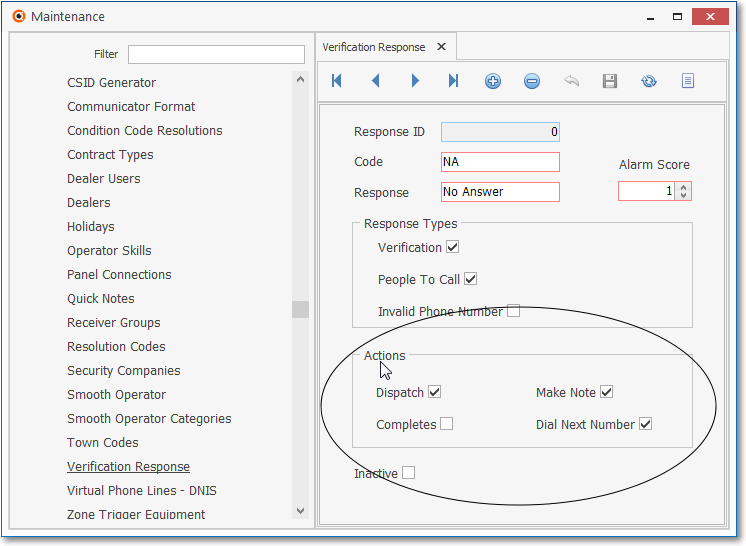❑Your Company's Central Station Operators perform a complex task, dealing with many possible variables, while executing proper Alarm Signal Processing procedures.
•To assist Operators, Predefined Procedures may be established for every Alarm Signal that requires a Response from an Operator.
•These Predefined Procedures may be determined using either the standard set of predefined Operator Guided Responses tools, or by creating a custom designed Action Plan Response.
•Both types of Predefined Procedures (either method may be implemented on a Zone by Zone basis, as needed) are created within the MKMS application, but are used by Operators within MKMSCS to Process Alarm Signals.
❑Operator Guided Responses - The UL® 1981 CLASSIFIED (and the Non-UL) Central Station Monitoring modules provide a set of Operator Guided Response procedures for all known (predefined) Alarm Signals, on a Subscriber by Subscriber and even Zone by Zone basis, as appropriate.
•This Operator Guided Response methodology, created to Process Alarm Signals:
✓Actually "walks" the Operator through each required Signal Processing step
✓Assures the proper completion of each step
✓Assures that each step is performed in the appropriate sequence
✓Assures that each specific Alarm Signal - regardless of which Operator Guided Response steps are needed - will be processed correctly.
•The tools used to implement this Operator Guided Response methodology are:

Alarm Conditions Form - Operator Skills, Priority & Reporting Options
1. Alarm Conditions - Because of the information identified for that Alarm Condition (e.g., the Type of Alarm, the Priority Level of the Alarm, and the Skills required to handle the Alarm), when an Alarm Condition is assigned to a Panel Zone and/or a CSID Zone, it will:
a.Display for the Operator the specific Type of Alarm Signal that is being processed
b.Set the Priority Level of that Alarm Signal
c.Identify the Operator Skill set that is needed to properly handle the Signal Processing procedures required for this Alarm Condition.
d.Determine how and where these Alarm Conditions and their associated Alarm Signals will be reported.

CSID Zone tab - Alarm Code (i.e., Alarm Condition) assigned
2. Subscriber Panel(s) - The CSID is entered in the Subscriber Panels section within the Edit View Monitoring Tab on the Subscribers Form to identify each Account that is to be monitored for that Subscriber.

Subscribers Form - Monitoring sub-tab - Subscriber Panel(s) section
3.Communicator Format - A Communicator Format must be assigned to the CSID when it is entered in the Subscriber Panels section

Communicator Format with Panel Zone showing the default steps
a.Each Communicator Format has a default set Panel Zones defined.
b.Panel Zones - Those default Panel Zones defined for each Communicator Format, identify all of the standard signals that may be transmitted to a Receiver using that Communicator Format, and each of these Panel Zones will also have the appropriate Alarm Condition assigned to it.
c.Therefore, when a Communicator Format is assigned to the Subscriber Panel(s) section's CSID, those predefined Panel Zones are also connected to that CSID.
d.When a Panel Zone represents an Active Signal (a Signal requiring an Operator Response), it also contains the default set of procedures which the Operator must perform when handling that Active Signal.
4.CSID Zones - When necessary, CSID Zones may be created when exceptions to the default Panel Zone information, processing procedures and/or descriptions for handling certain Alarm Signals are required.
✓These CSID Zones allow the default Panel Zone information/procedures/descriptions to be altered (substituted for the defaults) - thereby resetting the information/procedures/descriptions relating to Verification, and/or Dispatch, and/or Notification data that was defined in Panel Zones.

Subscriber Panels section - CSID Zones Form
✓CSID Zone Overrides - Exceptions to the handling of a CSID Zone may be defined using the CSID Zone Overrides tab (see the illustration immediately below) including:
a.The Day of the Week and/or the Time of the Day that they occur
b.The order in which the People To Call are to be contacted
c.The type of Dispatch required
d.A different Alarm Condition Code
e.A specially defined Action Plan (see Action Plans below)

Subscriber Panels section - CSID Zones - Overrides tab on the CSID Zones Form
5.Verification Response Codes - As Alarm Signals are handled by an Operator, predefined Verification Response Codes are selected by the Operator when a Verification, Dispatch, or Notification Contact attempt is made (successfully or not).
▪The selection of that Verification Response Code can also identify any additional Operator Guided Response step(s) based on the results of that defined Contact (as shown in the illustration below, these steps are defined in the Actions section on the Verification Response Form).

Verification Response Form
❑Action Plans - The alternative automated processing option to the Operator Guided Response is a User Defined Action Plan
•These Action Plans create an even more precise, step by step, set of user defined rules (which are referred to as the Action Steps of the Action Plan)
•The Action Steps can more finely control the appropriate "next step" resulting from virtually every variable an Operator may encounter while Process Alarms,
•Action Steps may also may display an Operator Script (if, and when appropriate) defining what to say when one of the Action Plan Steps requires a Verification, Dispatch, or Notification Contact.
❖See the Action Plan Overview chapter and its related sub-chapters for complete information for how to design an Action Plan, the Action Step options, and the appropriate use of Action Plans.